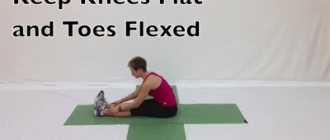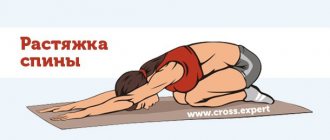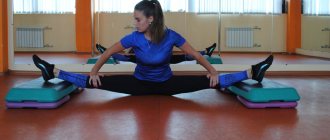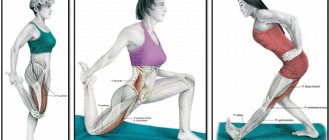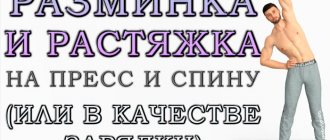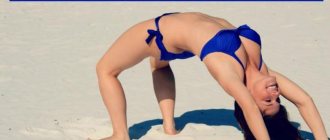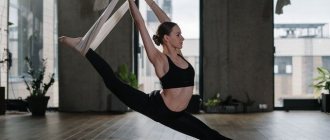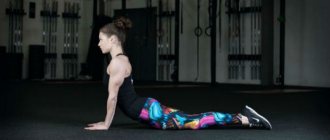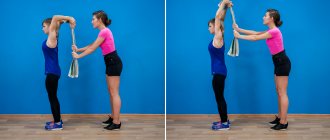Paired stretching can be a new and interesting way to train at home or an alternative to your favorite stretching, in which the load of your own weight is no longer enough. Working out as a couple is not just fun, but also an effective, more challenging option for developing body flexibility. We present to your attention the top 10 exercises for training together.
Benefits and Disadvantages of Stretching in Couples
Advantages:
- Helps increase the complexity and effectiveness of workouts.
- Helps improve mood by working in pairs.
- Helps diversify your training days.
- Speeds up results compared to single sessions.
Flaws:
- Training can take place in a group, so interaction with another person can only constrain , and mistrust can tighten the muscles, making it difficult to relax during stretching.
- High risk of injury. The whole point is that the second person, who puts pressure on the muscles of the other, does not feel the degree of load and pain of the partner, which threatens excessive impact on the muscle fibers, which can lead to injury.
Exercise makes you happier
According to researchers, couples who have just started intense physical activity together feel more satisfied with their relationship.
When working out together, people share a fitness goal, go for a run together, or have company at the gym. This also applies to friends. Pair stretching brings people together.
Recommendations for pair stretching
- Train no more than three times a week.
- Do not press or pull your partner sharply; act on his muscles smoothly, slowly bringing him to the extreme point of traction.
- Talk to your partner while doing the exercises. Ask about sensations so as not to cause harm, and talk about your own when you need to stop and, conversely, increase the impact on the fibers.
- Maintain the required time for stretching, it is different for everyone, so select the time individually, having previously agreed on this.
- Start your workout with a good warm-up before stretching. It is not necessary to perform the exercises in pairs.
- Breathe smoothly, do not hold your breath. Also, the exercises and the partner himself should not make it difficult for you to breathe. Keep an eye on this.
What are some stretching exercises?
Let's move on to the most interesting part - the exercises.
Camel Pose
Technique: Sit on your heels, take your arms back and push your hips forward and up without overstraining your lower back. If you have neck problems, do not throw your head back.
Muscles involved: rectus abdominis and external obliques.
Wide leg spread to the sides
Technique: in a sitting position, knees bent, back straight. Start slowly straightening your legs, slightly arching your back, try to touch your feet.
Muscles involved: adductors.
Frog pose
Technique: Get on all fours and slowly move your knees apart until you feel tension in your groin muscles.
Muscles involved: adductors.
Deep side lunge
Technique: Stand with your legs wide apart. Slowly lower your hands to your right foot, bending your right leg at the knee and raising your left toes up. The right foot is completely on the floor.
Muscles involved: adductors.
Butterfly pose
Technique: in a sitting position, lean your feet against each other, sit on your sit bones, straighten your back. Gently pressing your hands on your knees, lower your legs closer to the floor. The closer the feet are to the body, the stronger the muscle stretch.
Muscles involved: adductors.
Forearm stretch
Execution technique: lower your shoulder down and move it back, then fix it in the optimal position. Now start pressing on the opposite hand as shown in the picture.
Muscles involved: forearm extensor.
Neck stretch
Technique: stretching your neck as much as possible, slowly lower your ear to your shoulder.
Muscles involved: sternocleidomastoid.
Neck twists
Technique: Begin stretching the muscles by slowly rotating your neck and keeping your chin in a raised position. You can use your arm for a deeper stretch.
Muscles involved: sternocleidomastoid.
Head tilts back
Technique: Place your hands on your hips, straighten your back and begin to move your head back, being careful.
Muscles involved: sternocleidomastoid.
Head tilt to the side
Technique: straighten your neck as much as possible, try to touch your shoulder with your ear.
Muscles involved: sternocleidomastoid and upper trapezius.
Deep lunge with knee
Technique: get on your knee and slowly move your right hip forward. Grasp the back of your foot and tighten your gluteal muscle.
Muscles involved: psoas and quadriceps.
Forearm extensor stretch
Execution technique: lower your shoulder down and move it back, then fix it in the optimal position. Now start pressing on the opposite hand, as shown in the figure.
Muscles involved: forearm extensor.
Shoulder stretch
Technique: Straighten your arm across your body and apply light pressure to increase the stretch of the muscle.
Muscles involved: lateral deltoid
Neck flexion
In a standing position (legs together), with your back straight, slowly move your hips down and back, rounding your back and at the same time touching your chin to your chest.
Muscles involved: trapezius.
Back stretch
Grab the bar and slowly lift your feet off the floor.
Muscles involved: latissimus dorsi.
Stand with both hands on a corner of a wall or pillar. Keeping your back straight, slowly move your hips to the side.
Muscles involved: latissimus dorsi
Get on all fours and slowly move your hips back until your forehead touches the floor.
Muscles involved: latissimus dorsi.
Calf muscle stretch
Stand on the edge of the step and slightly rotate your ankles in and out to stretch your muscles.
Muscles involved: soleus and gastrocnemius.
Longitudinal twine
Begin the stretch by standing on one knee (as for a lunge), using caution if you have hip problems.
Muscles involved: soleus and gastrocnemius.
Stretch the back of the hips and knees
Sit on your sit bones and bend your knees if necessary. Try to grab your feet with your hands, straightening your knees. If this does not work, the exercise can be performed with bent knees, gradually increasing the tension in the legs.
Muscles involved: hamstrings and calves.
Place one foot in front of the other. Place your hands on your hips and, straightening your back, begin to bend from the hip.
Muscles involved: hamstrings.
Deep squat
Feet shoulder-width apart, and slowly squat down, straightening your arms between your legs and maintaining balance with your feet and hips.
Muscles involved: gluteals.
King Dove (sitting)
From a sitting position, slowly bring your leg toward your chest and externally rotate your hip while keeping your back straight.
Muscles involved: gluteals.
Calf stretch with support
Start in a lunge position with your back foot slightly outward. Slowly lower the heel of your back leg to the floor to stretch the muscles.
Muscles involved: soleus and gastrocnemius.
Restrictions and contraindications
Daily special exercises are not a panacea for all diseases, but rather a wonderful preventive measure that helps maintain flexibility. But be careful, be careful if you already have:
- osteoporosis;
- arthritis;
- osteochondrosis;
- kyphoscoliosis;
- vertebral hernia;
- injuries.
Then stretching for the back and spine is contraindicated.
In addition, any disease at the acute stage imposes restrictions on activities. High blood pressure, fever, colds, viral infections - you first need to get rid of them, and then start exercising with caution.
Advice: Follow the general conditions of physical therapy - exercise without overexertion, eliminate exercise if you feel weak. Poses should be performed with pleasure.
What results will you get in a month?
Restoring and strengthening muscles Relieving pain and tension from muscles Slowing down the aging process in the body Preserving muscle elasticity Relieving mental stress Improving posture
Our flexibility means having freedom of movement - an important part of all our actions. A personal stretching course is individually selected exercises for individual parts of your body, which will significantly improve your flexibility and coordination. This extra mobility is important because even the simplest tasks in our lives involve constant movement. Given this fact, stretching is even more important than exercise. Well, if you combine stretching routines with physical training, for example, morning jogging or dancing, you will become the owner of excellent health and well-being throughout your life!
SEVERAL REASONS TO GET INTO STRETCHING
The prospect of purchasing ballet plastic and correcting the figure is in itself a good reason for many to enroll in the stretching section
However, if you turn your attention to much more important aspects of training, it turns out that stretching brings great benefits to the body:
- promotes deep relaxation of the body, eliminates stiffness and tension in the muscles;
- promotes rapid muscle recovery after alternative physical activity;
- prevents age-related diseases of the musculoskeletal system;
- activates blood supply and, as a result, helps maintain the youth and beauty of the figure;
- prevents the development of spinal diseases and helps maintain posture;
- reduces the chances of getting injured both during sports and during everyday physical activity;
- relieves nervous tension and gives a great mood.
Selection of an instructor
Why is it so important to be guided by a personal trainer? Each student has different initial data and even different goals: someone dreams of a cross split, while others want a flexible back. To make stretching painless and effective, you need constant supervision from an instructor. That's why we are against group stretching classes. Stretching - only according to an individual program!
We will select an instructor for you who will create a training program based on your needs and goals! The trainer will assess which muscle groups need to be worked on in order to effectively achieve the desired result and will create a personal training program with individually selected exercises. We will arrange a lesson time that is convenient for you! All our trainers are masters of sports and have additional pedagogical education, with over 10 years of teaching experience. This ensures a careful approach to all the details that make up your success and result!
Benefits of exercise
A set of flexibility and stretching training will give a person:
- improved self-esteem, good mood, feeling of comfort and inner satisfaction;
- will help eliminate pain and tension at different points by eliminating muscle and nerve blocks;
- activates the cardiovascular system. The work of peripheral veins and arteries is important, since this is what helps eliminate long-standing ailments and prevent problems such as thrombosis, atherosclerosis, etc.;
- will return natural flexibility to the body and help rejuvenate the body;
- slimness, posture will always be majestic and straight;
- classes help to work out all muscle groups, including those that are not used during visits to the gym.
Stretching classes will be appropriate at any time of the day, including between strength training sessions. After just one month, a person notices the manifestation of the hidden capabilities of his own body. For example, you can easily and simply sit in the lotus position, or put your head on your lap. There are no limits to improving your capabilities, so with the passage of time and regular exercise, the amazing secrets of yoga can become available to you.
Stretching for dancers
Stretching is especially important for dancers. It should be done both before and after class. Since in this case stretching has an auxiliary function, a small set of exercises is sufficient.
- One leg should be bent at the knee, the other should be laid back (the part from the ankle to the knee is pressed to the floor). The back is straight, tension should be felt in the buttocks. Hands can be placed on the knee of the extended leg. You need to stay in this position for half a minute.
- Holding the back of a chair or other reliable support with one hand, bend one leg so that the heel rests on the pelvis. You should hold your leg with your free hand to hold this position for 30 seconds.
- To do this exercise, stand in front of a wall with one leg forward. The front leg then bends while the other leg remains straight. You need to extend your arms, with your palms resting on the wall. When performed correctly, the calf muscles become tense. The position is held for half a minute, as in all the following exercises.
- To perform this stretch, you need to use a rubber band. Lying on your back, bend one leg and place a tourniquet on the other foot. Then the leg with the tourniquet must be straightened and pulled up, while the ends of the tourniquet are tightly clenched in the hands.
How to do the exercises
Before the main exercise, take the time to lightly stretch the target muscle to avoid cramps and strain. Bring the muscle to a feeling of moderate tension and relax in this position. The tension created in the muscles should gradually go away.
- Hold each good stretch exercise in one position for about 30 seconds without sudden movements.
- Breathe slowly and deeply while stretching.
- Concentrate on how your muscles stretch and visualize it.
- Relax your whole body; never continue through pain or discomfort.
- Stretching warmed muscles will give better results. Stretch after every cardio or strength training session.
- Stretching between sets during strength training will help the target muscles recover faster and grow more.
- Having an experienced partner while you stretch will help you achieve better results.
Can stretching and flexibility exercises prevent sports injuries? Although stretching has not yet been proven to reduce the risk of sports injuries, practice shows that these exercises are indeed effective in stimulating muscle activity and increasing the range of motion of joints.
